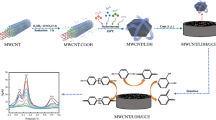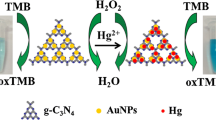Abstract
Hybrid nanoflowers consisting of graphitic carbon nitride (GCN) and copper were successfully constructed without the involvement of any biomolecule, by simply mixing them at room temperature to induce proper self-assembly to achieve a flower-like morphology. The resulting biomolecule-free GCN-copper hybrid nanoflowers (GCN-Cu NFs) exhibited an apparent peroxidase-mimicking activity, possibly owing to the synergistic effect from the coordination of GCN and copper, as well as their large surface area, which increased the number of catalytic reaction sites. The peroxidase-mimicking GCN-Cu NFs were then employed in the colorimetric determination of selected phenolic compounds hydroquinone (HQ), methylhydroquinone (MHQ), and catechol (CC). For samples without phenolic compounds, GCN-Cu NFs catalyzed the oxidation of the peroxidase substrate 3,3′,5,5′-tetramethylbenzidine (TMB) in the presence of H2O2, producing an intense blue color signal. Conversely, in the presence of phenolic compounds, the oxidation of TMB was inhibited, resulting in a significant reduction of the color signal. Using this strategy, HQ, MHQ, and CC were selectively and sensitively determined in a linear range up to 100 μM with detection limits down to 0.82, 0.27, and 0.36 μM, respectively. The practical utility of this assay system was also validated by using it to detect phenolic compounds spiked in tap water, yielding a good recovery of 97.1–108.9% and coefficient of variation below 3.0%, demonstrating the excellent reliability and reproducibility of this strategy.
Graphical abstract

Colorimetric determination of phenolic compounds using peroxidase mimics based on biomolecule-free hybrid nanoflowers consisting of graphitic carbon nitride and copper.





Similar content being viewed by others
References
Wu J, Wang X, Wang Q, Lou Z, Li S, Zhu Y, Qin L, Wei H (2019) Nanomaterials with enzyme-like characteristics (nanozymes): next-generation artificial enzymes (II). Chem Soc Rev 48:1004–1076
Huang Y, Ren J, Qu X (2019) Nanozymes: classification, catalytic mechanisms, activity regulation, and applications. Chem Rev 119:4357–4412
Shin HY, Park TJ, Kim MI (2015) Recent research trends and future prospects in nanozymes. J Nanomater 2015:756278
Song C, Ding W, Liu H, Zhao W, Yao Y, Yao C (2019) Label-free colorimetric detection of deoxyribonuclease I activity based on the DNA-enhanced peroxidase-like activity of MIL-53 (Fe). New J Chem 43:12776–12784
Kim MS, Lee J, Kim HS, Cho A, Shim KH, Le TN, An SSA, Han JW, Kim MI, Lee J (2020) Heme cofactor-resembling Fe–N single site embedded graphene as nanozymes to selectively detect H2O2 with high sensitivity. Adv Funct Mater 30:1905410
Jiao L, Xu W, Yan H, Wu Y, Liu C, Du D, Lin Y, Zhu C (2019) Fe–N–C single-atom nanozymes for the intracellular hydrogen peroxide detection. Anal Chem 91:11994–11999
Li B, Chen D, Wang J, Yan Z, Jiang L, Duan D, He J, Luo Z, Zhang J, Yuan F (2014) MOFzyme: intrinsic protease-like activity of Cu-MOF. Sci Rep 4
Yang J, Li J, Ng DHL, Yang P, Yang WN, Liu Y (2020) Micromotor-assisted highly efficient Fenton catalysis by a laccase/Fe-BTC-NiFe2O4 nanozyme hybrid with a 3D hierarchical structure. Environ Sci Nano 7:2573–2583
Lin T, Zhong L, Wang J, Guo L, Wu H, Guo Q, Fu F, Chen G (2014) Graphite-like carbon nitrides as peroxidase mimetics and their applications to glucose detection. Biosens Bioelectron 59:89–93
Kavitha R, Nithya PM, Kumar SG (2020) Noble metal deposited graphitic carbon nitride based heterojunction photocatalysts. Appl Surf Sci 508:145142
Qiao F, Wang J, Ai S, Li L (2015) As a new peroxidase mimetics: the synthesis of selenium doped graphitic carbon nitride nanosheets and applications on colorimetric detection of H2O2 and xanthine. Sensors Actuators B Chem 216:418–427
Wang Y-M, Liu J-W, Adkins GB, Shen W, Trinh MP, Duan L-Y, Jiang J-H, Zhong W (2017) Enhancement of the intrinsic peroxidase-like activity of graphitic carbon nitride nanosheets by ssDNAs and its application for detection of exosomes. Anal Chem 89:12327–12333
Heo NS, Song HP, Lee SM, Cho H-J, Kim HJ, Huh YS, Kim MI (2020) Rosette-shaped graphitic carbon nitride acts as a peroxidase mimic in a wide pH range for fluorescence-based determination of glucose with glucose oxidase. Microchim Acta 187:286
Tran TD, Kim MI (2018) Organic-inorganic hybrid nanoflowers as potent materials for biosensing and biocatalytic applications. Biochip J 12:268–279
Cui J, Jia S (2017) Organic–inorganic hybrid nanoflowers: a novel host platform for immobilizing biomolecules. Coord Chem Rev 352:249–263
Ge J, Lei J, Zare RN (2012) Protein–inorganic hybrid nanoflowers. Nat Nanotechnol 7:428–432
Wu S, Guo D, Xu X, Pan J, Niu X (2020) Colorimetric quantification and discrimination of phenolic pollutants based on peroxidase-like Fe3O4 nanoparticles. Sensors Actuators B Chem 303:127225
Jun YS, Park J, Lee SU, Thomas A, Hong WH, Stucky GD (2013) Three-dimensional macroscopic assemblies of low-dimensional carbon nitrides for enhanced hydrogen evolution. Angew Chem Int Ed 52:11083–11087
Batule BS, Park KS, Gautam S, Cheon HJ, Kim MI, Park HG (2019) Intrinsic peroxidase-like activity of sonochemically synthesized protein copper nanoflowers and its application for the sensitive detection of glucose. Sensors Actuators B Chem 283:749–754
Kim MS, Cho S, Joo SH, Lee J, Kwak SK, Kim MI, Lee J (2019) N-and B-codoped graphene: a strong candidate to replace natural peroxidase in sensitive and selective bioassays. ACS Nano 13:4312–4321
Jin R, Kong D, Zhao X, Li H, Yan X, Liu F, Sun P, Du D, Lin Y, Lu G (2019) Tandem catalysis driven by enzymes directed hybrid nanoflowers for on-site ultrasensitive detection of organophosphorus pesticide. Biosens Bioelectron 141:111473
Cheon HJ, Adhikari MD, Chung M, Tran TD, Kim J, Kim MI (2019) Magnetic nanoparticles-embedded enzyme-inorganic hybrid nanoflowers with enhanced peroxidase-like activity and substrate channeling for glucose biosensing. Adv Healthcare Mater 8:1801507
Lee I, Cheon HJ, Adhikari MD, Tran TD, Yeon KM, Kim MI, Kim J (2020) Glucose oxidase-copper hybrid nanoflowers embedded with magnetic nanoparticles as an effective antibacterial agent. Int J Biol Macromol 155:1520–1531
Ge L, Han C, Liu J, Li Y (2011) Enhanced visible light photocatalytic activity of novel polymeric g-C3N4 loaded with Ag nanoparticles. Appl Catal A Gen 409:215–222
Wu N, Wang Y-T, Wang X-Y, Guo F-N, Wen H, Yang T, Wang JH (2019) Enhanced peroxidase-like activity of AuNPs loaded graphitic carbon nitride nanosheets for colorimetric biosensing. Anal Chim Acta 1091:69–75
Gao L, Zhuang J, Nie L, Zhang J, Zhang Y, Gu N, Wang T, Feng J, Yang D, Perrett S (2007) Intrinsic peroxidase-like activity of ferromagnetic nanoparticles. Nat Nanotechnol 2:577–583
Huang Y, Ran X, Lin Y, Ren J, Qu X (2015) Self-assembly of an organic–inorganic hybrid nanoflower as an efficient biomimetic catalyst for self-activated tandem reactions. Chem Commun 51:4386–4389
Song Y, Zhao M, Li H, Wang X, Cheng Y, Ding L, Fan S, Chen S (2018) Facile preparation of urchin-like NiCo2O4 microspheres as oxidase mimetic for colormetric assay of hydroquinone. Sensors Actuators B Chem 255:1927–1936
Yuan Y, Gou X, Yuan R, Chai Y, Zhuo Y, Mao L, Gan X (2011) Electrochemical aptasensor based on the dual-amplification of G-quadruplex horseradish peroxidase-mimicking DNAzyme and blocking reagent-horseradish peroxidase. Biosens Bioelectron 26(10):4236–4240
Wang X, Zhao M, Song Y, Liu Q, Zhang Y, Zhuang Y, Chen S (2019) Synthesis of ZnFe2O4/ZnO heterostructures decorated three-dimensional graphene foam as peroxidase mimetics for colorimetric assay of hydroquinone. Sensors Actuators B Chem 283:130–137
Zhang L-P, Xing Y-P, Liu L-H, Zhou X-H, Shi H-C (2016) Fenton reaction-triggered colorimetric detection of phenols in water samples using unmodified gold nanoparticles. Sensors Actuators B Chem 225:593–599
Keshvari F, Bahram M (2017) Selective, sensitive and reliable colorimetric sensor for catechol detection based on anti-aggregation of unmodified gold nanoparticles utilizing boronic acid–diol reaction: optimization by experimental design methodology. J Iran Chem Soc 14:977–984
Hayat A, Cunningham J, Bulbul G, Andreescu S (2015) Evaluation of the oxidase like activity of nanoceria and its application in colorimetric assays. Anal Chim Acta 885:140–147
Alkasir RS, Ornatska M, Andreescu S (2012) Colorimetric paper bioassay for the detection of phenolic compounds. Anal Chem 84:9729–9737
Zhou X-H, Liu L-H, Bai X, Shi H-C (2013) A reduced graphene oxide based biosensor for high-sensitive detection of phenols in water samples. Sensors Actuators B Chem 181:661–667
Funding
This work was supported by a National Research Foundation of Korea (NRF) grant funded by the Korea government (Ministry of Science and ICT (NRF-2019R1A2C1087459) and by the Gachon University Research Fund of 2019 (GCU-2019-0812). This work was also supported by the Korean National Police Agency (Project name: Development of visualization technology for biological evidence in crime scenes based on nano-bio technology/Project Number: PA-K000001-2019-401].
Author information
Authors and Affiliations
Corresponding authors
Ethics declarations
Conflict of interest
The authors declare no competing interests.
Additional information
Publisher’s note
Springer Nature remains neutral with regard to jurisdictional claims in published maps and institutional affiliations.
Supplementary information
ESM 1
(PDF 1.13 mb)
Rights and permissions
About this article
Cite this article
Dang, T.V., Heo, N.S., Cho, HJ. et al. Colorimetric determination of phenolic compounds using peroxidase mimics based on biomolecule-free hybrid nanoflowers consisting of graphitic carbon nitride and copper. Microchim Acta 188, 293 (2021). https://doi.org/10.1007/s00604-021-04937-4
Received:
Accepted:
Published:
DOI: https://doi.org/10.1007/s00604-021-04937-4




